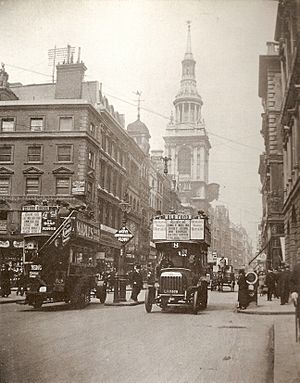Cheapside Hoard facts for kids

The Cheapside Hoard is a huge collection of old jewellery. It was found by chance in 1912 in a cellar in Cheapside, London. Workmen were digging when they hit a buried wooden box. Inside were over 400 pieces of jewellery from the late 1500s and early 1600s.
This amazing find included rings, brooches, and chains. They had bright gemstones and gold decorated with enamel. Other cool items were "toadstones," cameos (carved jewels), perfume bottles, and crystal cups.
Today, most of the Cheapside Hoard is kept at the Museum of London. Some pieces are also at the British Museum and the Victoria and Albert Museum.
Contents
Where Was the Hoard Found?
The Cheapside Hoard was discovered in a part of London that was once a busy shopping area. This spot, 30–32 Cheapside, was likely where a goldsmith (a person who makes things from gold) had their shop.
A Goldsmith's Hidden Treasure
Experts believe the hoard was a jeweller's valuable stock. It was probably buried for safety during the English Civil War. This war happened in England from 1642 to 1651. Cheapside was the main shopping street in London back then. Many shops selling fancy goods were there, including lots of goldsmiths.
The area where the hoard was found was known as Goldsmith's Row. It was owned by the Worshipful Company of Goldsmiths. This group has been important in London's gold and jewellery trade for hundreds of years.
The Great Fire of London
Goldsmith's Row was destroyed in the Great Fire of London in 1666. The buildings were rebuilt soon after. In 1912, these buildings were being redeveloped. That's when workmen found the hoard hidden in the old cellar. Today, this spot is under a modern building called One New Change.
What's Inside the Hoard?
The Cheapside Hoard shows how much trade happened around the world long ago. The gemstones in the hoard came from many different places.
Gemstones from Around the World
You can find emeralds from Colombia and topaz from Brazil. There are also spinel and chrysoberyl from Sri Lanka. Diamonds came from India, and rubys from Burma. Other stones include lapis lazuli from Afghanistan and turquoise from Iran. Pearls came from Bahrain, and peridot from the Red Sea. Even opal, garnet, and amethyst from Europe are in the collection.
Many of the stones are cut in a smooth, rounded shape called a cabochon. But some have more modern faceted cuts, which make them sparkle.
Special Items in the Hoard
One amazing piece is a large Colombian emerald. It was once as big as an apple. It was hollowed out to hold a tiny Swiss watch movement from around 1600!
Other cool items include a carved gemstone cameo from ancient times. There's also a cameo of Queen Elizabeth I herself. An emerald carved like a parrot is another unique piece. Some "fake" gemstones made of carved and dyed quartz are also part of the hoard.
A small red stone seal has the family crest of William Howard, 1st Viscount Stafford. This helps experts guess when the hoard was buried. It must have been hidden between 1640 and 1666. Most of the gold in the hoard is very pure, about 80% gold.
How the Hoard Was Saved
The workmen who found the hoard sold some pieces to a man known as "Stoney Jack." His real name was George Fabian Lawrence. He was an antiques dealer who often bought interesting finds from building sites in London. He also worked for the Guildhall Museum and later the London Museum.
Finding a Home for the Jewels
The Goldsmiths' Company did not claim the jewels as theirs. So, a special legal process for finding treasure was not needed. A generous person named Lewis Vernon Harcourt, 1st Viscount Harcourt gave money for the London Museum to buy most of the Cheapside Hoard. A few pieces went to the British Museum and the Guildhall Museum. One gold and enamel chain was bought by the Victoria and Albert Museum.
The finds were first shown to the public at the London Museum in 1914. People loved seeing them! Later, the Guildhall Museum and the London Museum joined together in 1975. They formed the Museum of London, where most of the hoard is now.
The entire Cheapside Hoard was displayed together for the first time in over 100 years at the Museum of London. This special exhibition ran from October 2013 to April 2014.

